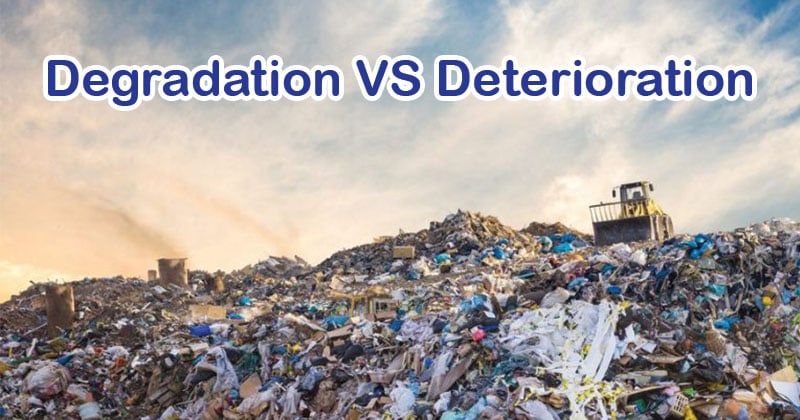- Nature has always provided, in considerable amounts and variety, polymeric materials with interesting compositions and structures.
- These natural polymers include polysaccharides, such as cellulose, chitin, starch, alginate, galactan, hyaluronic acid, dextran, and gellan, obtained from plants, animals, and microbial sources and polyesters, such as poly(b-hydroxybutyrate) and poly(b-hydroxybutyrate-co-b–hydroxyvalerate), produced by numerous bacteria.
- In biological systems, polysaccharides and their derivatives are found as energy reservoirs, as components of the cell wall of plants, in bacteria, and in the connective tissues.
Both degradation and deterioration processes involve the breakdown of materials including polymers. However, there is a distinction between ‘biodegradation’ and ‘biodeterioration’.
Whereas ‘biodegradation’ is concerned with the use of microorganisms to modify materials with a positive or useful purpose, ‘biodeterioration’ refers to the ‘negative impact of live-organisms activity’. Biological process/(es) are the primary cause of deterioration in biodeterioration.

Interesting Science Videos
Degradation
- The reduction of a chemical compound to one less complex, as by splitting off one or more groups is called degradation.
- Biological degradation of natural and some synthetic polymers occurs when polymer depolymerization takes place as the result of enzyme secretions by some microorganisms.
- These enzymes either oxidize or hydrolyze the polymer by attacking the polymer chain’s main functional chain and end groups so that polymer chains with either oxygen or nitrogen or both with low levels of crystallinity are most susceptible.
- Natural fibers fitting most of these criteria are therefore highly biodegradable whereas synthetic fibers such as polypropylene and polyethylene are least likely to be biologically attacked and then degrade.
- Aromatic polyesters and polyamides, despite having oxygen and nitrogen in their respective molecular chains, also resist biodegradation largely because of their molecular chain rigidity and high levels of crystallinity.
- Material degradation results from the complex interaction between physical, chemical and biological degradation processes.
- The term biodegradation is often used to denote degradation occurring in a biological environment. It may be defined as the “gradual breakdown of a material mediated by a specific biological activity”.
- Degradation is an important process to transform or accumulate environmental pollutants, including hydrocarbons (e.g. oil), polychlorinated biphenyls (PCBs), polyaromatic hydrocarbons (PAHs), heterocyclic compounds (such as pyridine or quinoline), pharmaceutical substances, radionuclides, and metals.
- Moreover, it also ensures proper nutrient cycling in the environment.
Deterioration
- Deterioration refers to the action or process of becoming impaired or inferior in quality, functioning, or condition.
- Deterioration is defined as a loss of structural capacity with time as a result of the action of the external agents or material leaching (Sanchez-Silva et al. 2008).
- Biodeterioration in its widely accepted form of definition is: “any undesirable change in the properties of a material caused by the vital activities of organisms” (Hueck, 1968).
- Another definition is: “the process by which biological agents (i.e. live organisms) are the cause of the (structural) lowering in quality or value”
- The process of deterioration of materials induced by outdoor environmental factors is a complex interplay of the effects of climate and local meteorological characteristics, of biological processes and frequently of complicated chemical processes resulting from the impact of pollutants and natural constituents from the surrounding environment.
- Except for the decay caused by cataclysmic events, the principal natural environmental factors affecting the deterioration of materials include, but are not limited to, moisture, temperature, solar radiation, air movement and pressure, precipitation, chemical and biochemical attack, and intrusion by micro and macro-organisms.
- Natural factors, together with those expected to be a part of the pollution processes, continuously promote weathering and material decay, including metal corrosion.
- Biological deterioration caused by insect attack and/or fungal growth and the other form of deterioration is caused by adverse environmental conditions such as extremes of dampness or wide fluctuations in relative humidity associated with large variations in day and night temperatures, light and atmospheric pollutants.
Biological Factors of Deterioration
- Where there is condensation or moisture due to high humidity, there is always the presence of biological growths such as molds or fungi, insects and rodents causing an infestation.
- Biological agents attack paper and other organic materials when both temperature and humidity are uncontrolled.
- Mold spores remain suspended in the air until they find suitable conditions for their growth. If mold is observed in the collection yet environmental conditions are not altered to halt its proliferation, the mold will digest the material on which it has begun to grow.
- This results in the staining and deterioration of materials attacked and in rapid loss of strength of organic materials.
References
- https://www.biology-online.org/dictionary/Degradation
- https://www.sciencedirect.com/topics/chemistry/biological-degradation
- https://core.ac.uk/download/pdf/55614175.pdf
- http://www.scielo.br/scielo.php?script=sci_arttext&pid=S0100-40422015000200259
- https://www.tandfonline.com/doi/abs/10.1179/1743284713Y.0000000503?journalCode=ymst20
- http://cool.conservation-us.org/byauth/maravilla/deterioration-causes.html
- https://www.witpress.com/Secure/elibrary/papers/9781845640323/9781845640323001FU1.pdf
- http://www.scielo.br/scielo.php?script=sci_arttext&pid=S0100-40422015000200259
- https://www.merriam-webster.com/dictionary/deterioration
- http://shodhganga.inflibnet.ac.in/bitstream/10603/5590/10/10_chapter%202.pdf
- Sterflinger, K., & Piñar, G. (2013). Microbial deterioration of cultural heritage and works of art–tilting at windmills?. Applied microbiology and biotechnology, 97(22), 9637-46.
